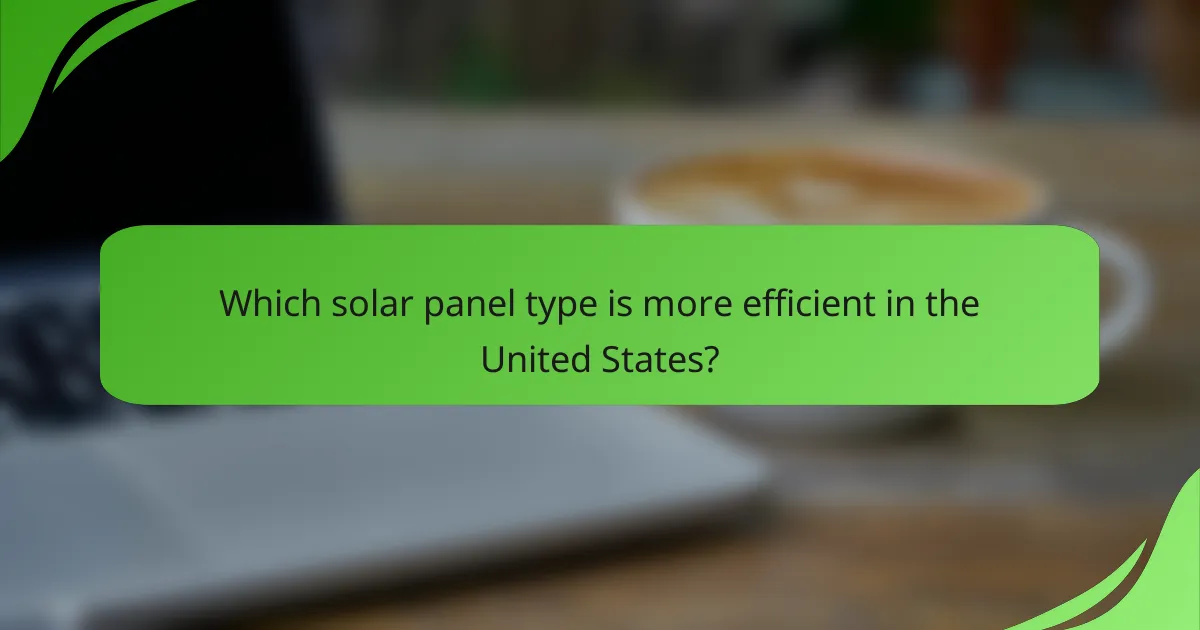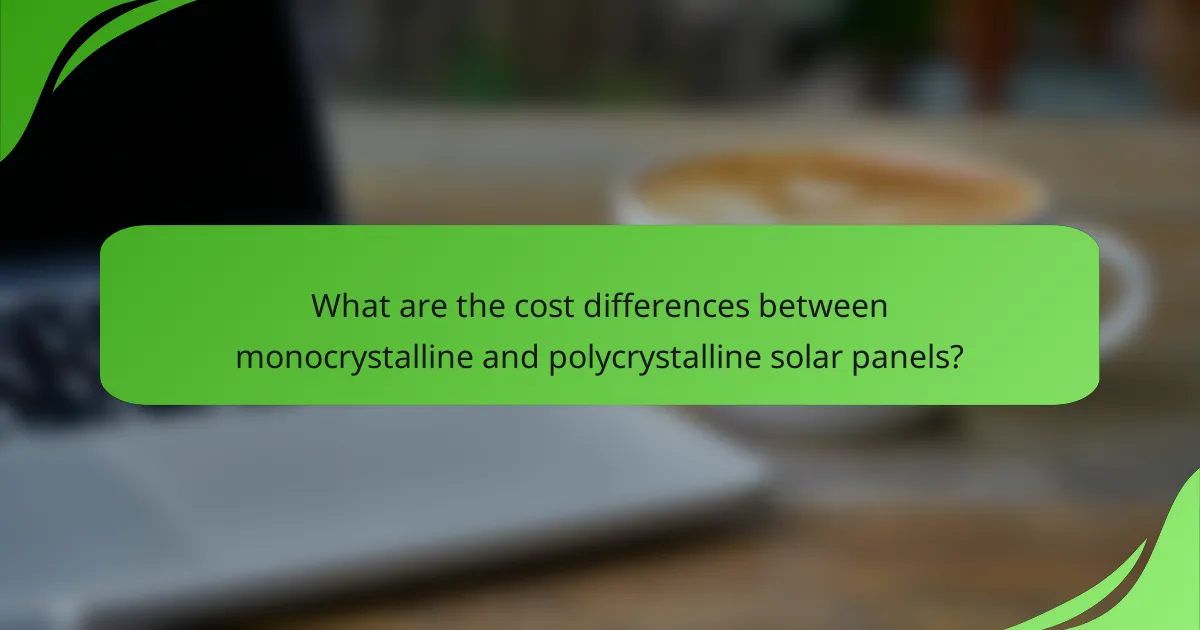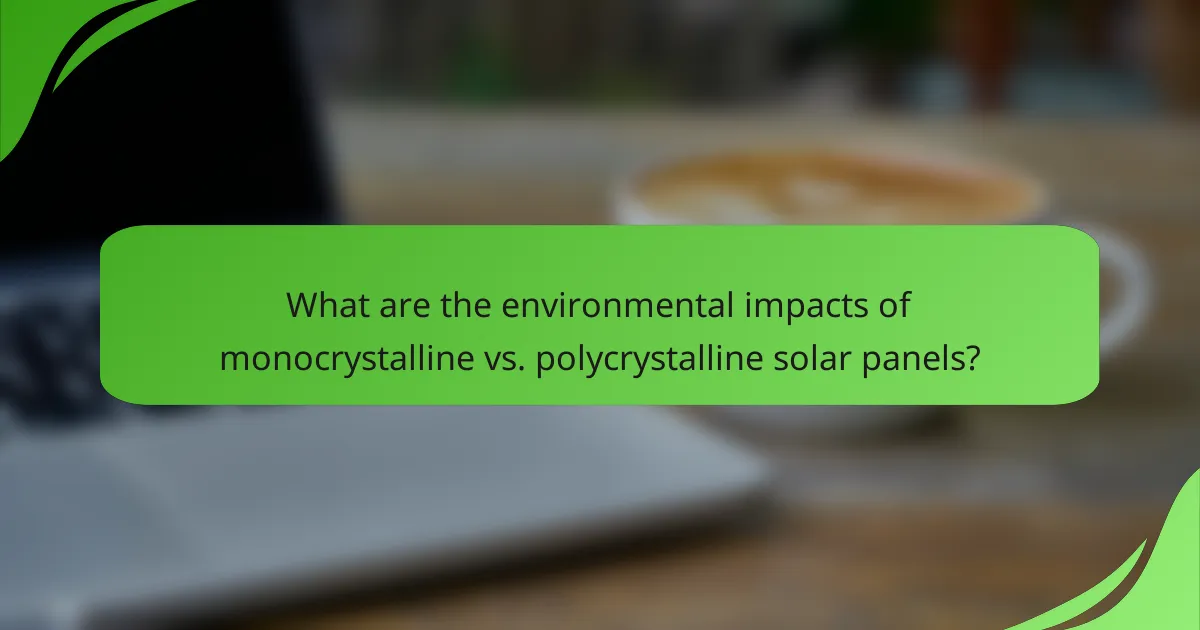When choosing between monocrystalline and polycrystalline solar panels, it’s essential to consider their performance, cost, and lifespan. Monocrystalline panels are known for their higher efficiency and longer lifespan, often lasting over 25 years, making them a popular choice despite their higher initial cost. In contrast, polycrystalline panels are generally more affordable but may offer lower energy output and a shorter lifespan.

Which solar panel type is more efficient in the United States?
In the United States, monocrystalline solar panels are generally more efficient than polycrystalline panels. This means they convert a higher percentage of sunlight into usable electricity, making them a preferred choice for many homeowners and businesses.
Monocrystalline panels offer higher efficiency
Monocrystalline solar panels are made from a single crystal structure, allowing them to achieve efficiencies typically ranging from 15% to over 22%. Their design enables better performance in low-light conditions and higher temperatures, which is beneficial in various climates across the U.S.
Due to their higher efficiency, monocrystalline panels often require less space for installation compared to polycrystalline options. This makes them ideal for residential rooftops where space may be limited.
Polycrystalline panels have lower efficiency
Polycrystalline solar panels are composed of multiple crystal structures, resulting in lower efficiencies, generally between 13% and 17%. While they are less efficient than monocrystalline panels, they tend to be more affordable, making them a cost-effective option for larger installations where space is not a constraint.
Despite their lower efficiency, polycrystalline panels can still provide significant energy savings over their lifespan. They are a suitable choice for homeowners looking for a balance between initial investment and long-term performance.

What are the cost differences between monocrystalline and polycrystalline solar panels?
Monocrystalline solar panels typically cost more than polycrystalline panels due to their manufacturing process and efficiency. However, the initial investment can be offset by their higher energy output and longer lifespan.
Monocrystalline panels are generally more expensive
Monocrystalline panels are made from single-crystal silicon, which requires a more complex manufacturing process. This results in higher production costs, making these panels typically more expensive, often ranging from 20% to 50% more than their polycrystalline counterparts.
Despite the higher upfront cost, monocrystalline panels offer greater efficiency and a longer lifespan, often exceeding 25 years. This can lead to better long-term savings on energy bills, making them a worthwhile investment for many homeowners.
Polycrystalline panels are more budget-friendly
Polycrystalline panels are produced from multiple silicon crystals, which makes the manufacturing process simpler and less expensive. As a result, these panels are generally more budget-friendly, with prices often lower than monocrystalline panels by about 10% to 30%.
While polycrystalline panels may have slightly lower efficiency and a shorter lifespan, they still provide a reliable energy source for those looking to minimize initial costs. They are a good option for homeowners on a tighter budget or those with less roof space.

How do the lifespans of monocrystalline and polycrystalline panels compare?
Monocrystalline solar panels generally have a longer lifespan compared to polycrystalline panels, often lasting 25 years or more. This difference in longevity can significantly impact long-term investment and energy production efficiency.
Monocrystalline panels typically last longer
Monocrystalline panels are known for their durability, often rated to last between 25 to 30 years. Their construction, which involves a single crystal structure, contributes to their resilience against environmental factors such as temperature fluctuations and shading.
Many manufacturers offer warranties of 25 years or more for monocrystalline panels, reflecting their confidence in the product’s longevity. This extended lifespan can lead to a better return on investment over time, as homeowners may benefit from consistent energy production for decades.
Polycrystalline panels have a shorter lifespan
Polycrystalline panels typically have a lifespan ranging from 20 to 25 years, which is shorter than that of their monocrystalline counterparts. The multiple crystal structures in polycrystalline panels can make them slightly less efficient and more susceptible to wear over time.
While many polycrystalline panels come with warranties of around 20 years, their shorter lifespan may result in decreased energy production and higher replacement costs in the long run. Homeowners should consider this factor when evaluating their solar panel options and potential savings.

What factors should you consider when choosing between monocrystalline and polycrystalline panels?
When choosing between monocrystalline and polycrystalline solar panels, consider efficiency, budget, and lifespan. Each type has distinct advantages and trade-offs that can significantly impact your solar energy system’s performance and overall cost.
Efficiency needs based on location
Efficiency is crucial, especially in areas with limited sunlight. Monocrystalline panels typically offer higher efficiency rates, often exceeding 20%, making them ideal for locations with lower solar exposure. In contrast, polycrystalline panels generally have efficiencies in the range of 15-17%, which may suffice in sunnier regions.
Consider your roof space as well; if you have limited area, monocrystalline panels can generate more power per square meter. However, if your location receives ample sunlight year-round, polycrystalline panels can still provide a viable and cost-effective solution.
Budget constraints for installation
Budget is a significant factor when selecting solar panels. Monocrystalline panels tend to be more expensive upfront, often costing 20-30% more than polycrystalline options. This higher cost is due to their manufacturing process and efficiency benefits.
When planning your installation, factor in long-term savings on energy bills. While polycrystalline panels may have lower initial costs, their slightly lower efficiency could lead to higher costs over time if you need more panels to meet your energy needs. Assess your financial situation and consider potential incentives or rebates that may be available for solar installations in your area.

How do climate conditions affect solar panel performance?
Climate conditions significantly influence solar panel performance, affecting energy output and efficiency. Factors such as temperature, humidity, and light availability can enhance or diminish the effectiveness of both monocrystalline and polycrystalline panels.
Monocrystalline panels perform better in low-light conditions
Monocrystalline solar panels are known for their superior efficiency in low-light environments, such as cloudy or shaded areas. Their design allows them to convert sunlight into electricity more effectively, often achieving higher energy output even when sunlight is limited.
This makes monocrystalline panels a suitable choice for regions with frequent overcast weather or for installations where shading from trees or buildings is a concern. Homeowners in such areas may find that investing in monocrystalline technology yields better performance and energy savings.
Polycrystalline panels may underperform in extreme heat
Polycrystalline solar panels tend to experience a drop in efficiency when exposed to high temperatures. As temperatures rise, the energy conversion efficiency can decrease, leading to lower overall power output compared to monocrystalline panels.

What are the environmental impacts of monocrystalline vs. polycrystalline solar panels?
Monocrystalline and polycrystalline solar panels have distinct environmental impacts primarily due to differences in their production processes and energy efficiency. Monocrystalline panels generally offer higher energy payback, while polycrystalline panels are produced with less energy input.
Monocrystalline panels have a higher energy payback
Monocrystalline solar panels typically achieve a higher energy payback period, meaning they generate more energy over their lifespan compared to polycrystalline panels. This efficiency translates to a quicker return on the energy invested in their production, often within 1-3 years depending on sunlight exposure and installation conditions.
For example, in regions with high solar insolation, monocrystalline panels can produce around 20% more energy than their polycrystalline counterparts. This makes them a favorable choice for those prioritizing long-term energy output and sustainability.
Polycrystalline panels use less energy in production
Polycrystalline solar panels are manufactured using a simpler process that requires less energy compared to monocrystalline panels. This lower energy requirement during production can reduce the overall carbon footprint associated with their lifecycle.
While polycrystalline panels may have a longer energy payback period, typically ranging from 3-5 years, their lower production energy can be beneficial in areas where energy resources are limited or where sustainability is a key concern. Choosing polycrystalline panels can be a practical option for environmentally conscious consumers looking to minimize initial energy costs.

What are the installation considerations for each type of solar panel?
When installing solar panels, the type of panel—monocrystalline or polycrystalline—affects space requirements, mounting area, and overall efficiency. Understanding these considerations helps in making an informed choice based on available roof space and energy needs.
Monocrystalline panels require less space
Monocrystalline solar panels are known for their high efficiency, typically ranging from 15% to 22%. This means they can generate more electricity per square meter compared to other types, making them ideal for installations with limited space.
Due to their compact design, fewer monocrystalline panels are needed to achieve the same energy output as polycrystalline panels. This can be particularly beneficial in urban areas where roof space is at a premium.
Polycrystalline panels may need more mounting area
Polycrystalline solar panels generally have a lower efficiency, usually between 13% and 16%. As a result, more panels are required to produce the same amount of energy, which necessitates a larger mounting area.
When planning an installation, consider that the additional space needed for polycrystalline panels may impact roof aesthetics and structural load. Ensure that the roof can support the extra weight and that there is sufficient area to accommodate the required number of panels.

What are the future trends in solar panel technology?
Future trends in solar panel technology focus on increasing efficiency, reducing costs, and enhancing sustainability. Innovations such as bifacial panels, perovskite materials, and improved energy storage solutions are expected to shape the market.
Increased Efficiency
Solar panel efficiency is continually improving, with advancements in materials and design. Monocrystalline panels currently lead the market with efficiencies often exceeding 20%, while polycrystalline panels typically range from 15% to 20%. Future technologies, like tandem cells, could push efficiencies even higher.
Manufacturers are investing in research to develop panels that can capture more sunlight and convert it into usable energy. This could mean smaller installations producing more power, which is particularly beneficial for urban areas with limited space.
Cost Reduction
The cost of solar panels has been decreasing steadily over the past decade, making solar energy more accessible. As production methods improve and economies of scale are realized, prices are expected to drop further. Currently, the average cost for solar installations in the U.S. is around $3 to $4 per watt.
Government incentives and subsidies can also play a significant role in reducing upfront costs for consumers. It’s essential to stay informed about local and federal programs that can assist with financing solar projects.
Sustainability and Recycling
As the solar industry grows, so does the focus on sustainability and the lifecycle of solar panels. Future trends will likely include the development of recyclable materials and processes to minimize waste. Companies are exploring ways to repurpose old panels, which could significantly reduce environmental impact.
Regulations may evolve to require manufacturers to take responsibility for the disposal and recycling of solar panels, ensuring that the industry remains environmentally friendly. Consumers should consider the sustainability practices of manufacturers when choosing solar products.
